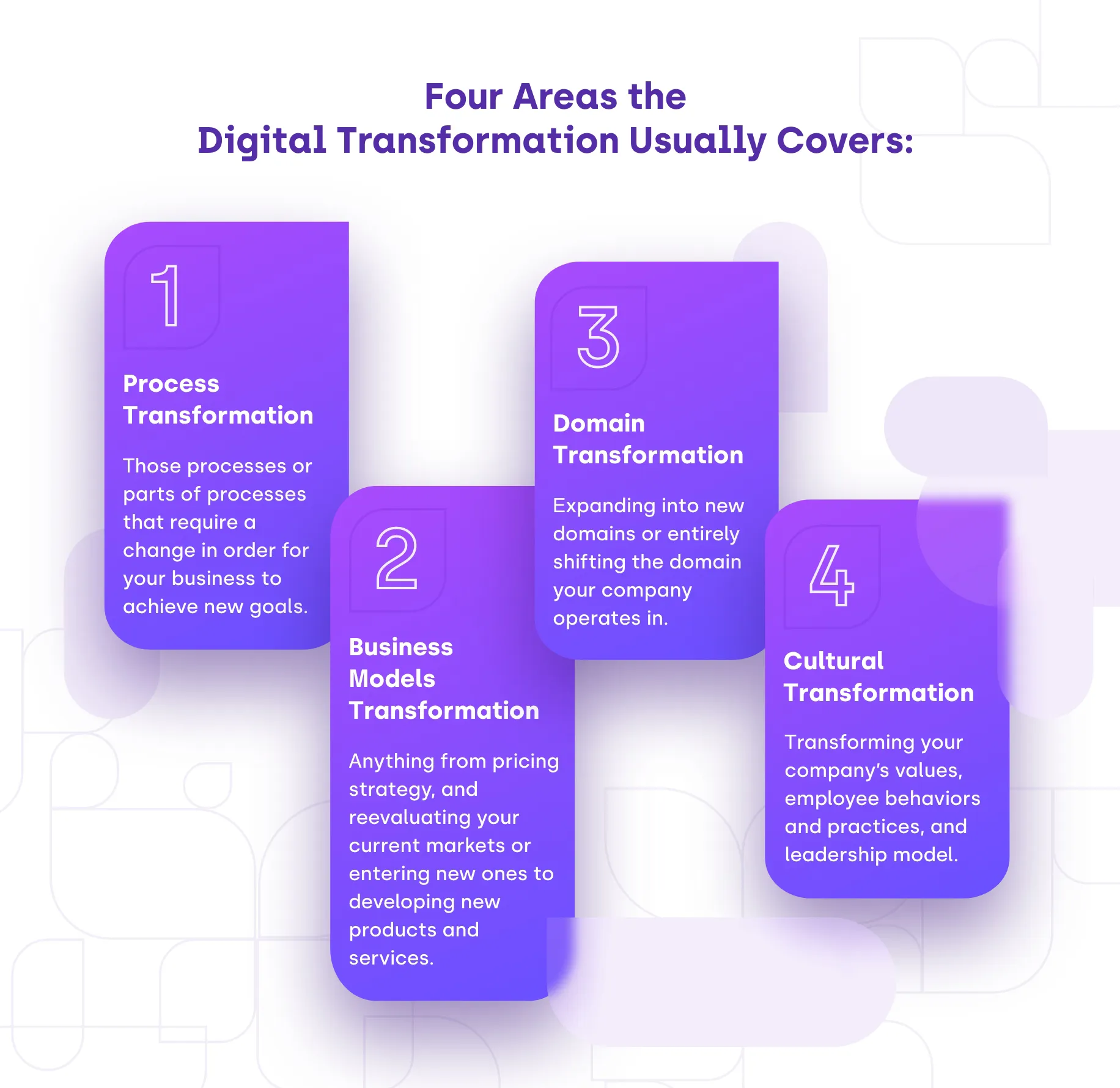
Digital transformation journey: Why and how?

The importance and pace of the adoption of digital technologies have grown significantly over the last few years. Digital strategies and investments have increased, and embarking on a digital transformation journey has become a central goal for an organization.
In the midst of chasing after that goal, one question that frequently falls by the wayside is - why? Why set off on a digital transformation journey in the first place? Why devote so much time and resources to restructuring how your company operates and produces value?
Why should you embark on a digital transformation journey?
The main reason to engage in digital transformation is, of course, in order to remain competitive and relevant in the market and create business growth. A thoroughly executed digital transformation strategy helps companies cover a lot of ground.
On the one hand, it enables them to respond to the greater diversity and complexity of customer needs - the so-called new digital customer experience. With digital transformation, companies can provide an omnichannel, personalized, and instant service.
On the other, greater and smarter digitalization also helps businesses reach digital transformation goals such as adapting to disruptions in the supply chain, increasing profitability and improving their speed-to-market. Internally, it helps them optimize business processes, create greater connections and better communication between departments, and become more productive.
At heart, this is why a digital transformation initiative matters. In the past, IT and software investments were seen as a cost. Now, they are a central (if not the central) source of value that allows companies to reenvision and differentiate themselves and to serve customers in ever more innovative ways.
4 key steps when starting your digital transformation journey
Where and how to begin is one of the big questions of digital transformation. There’s a lot of research, planning, and preparation to be done that will help you arrive at your destination safely.
To begin, here are several essential steps you must cover as you embark on your journey.
1. Define what digital transformation means to your company
What is digital transformation? It doesn’t mean the same thing to everyone. Your industry and competitors, your company’s size, your current level of digitalization, your customers’ needs, and your existing value chain all play a role in how and what exactly you transform.
Each of these contextual aspects may contain challenges for you that you need to establish to determine the proper transformation approach for bringing the business forward. So, as you set out, spend time gauging your unique situation and thinking about what you need to change.


A useful model to consider as you assess your specific situation is the four areas that digital transformation usually covers:
- Process transformation - those processes or parts of processes that require a change in order for your business to achieve new goals
- Business models transformation - anything from pricing strategy, and reevaluating your current markets or entering new ones to developing new products and services
- Domain transformation- expanding into new domains or entirely shifting the domain your company operates in
- Cultural transformation- transforming your company’s values, employee behaviors and practices, and leadership model
2. Determine how your business will go digital and choose the right digital technology
Defining what digital initiatives will mean to your company and which of the above areas they will cover allows you to consider the digital solutions you need and how to implement them. Will your transformation involve a legacy system overhaul, front- and/or back-end transformation, or is it more about adopting new digital technology, or maybe both?
As an example, major strategies and technologies in which best-in-class companies are investing (from last year’s McKinsey Global Survey) include:
- The rapid adoption of public cloud solutions
- The rapid adoption of public cloud solutions
- Investments in agile and DevOps practices
- Greater use of automated processes for testing and deploying
- Developing software and technologies that enhance existing offerings
- Making use of artificial intelligence (AI) for improved decision making
- Developing proprietary data
These are some of the possible approaches you can take to your digitalization. Digital transformation is not an end in itself. The important point when adopting or modernizing solutions is how these will help you bring new value to your customers and transform your business. Based on this, you can start creating your transformation strategy.
3. Find the right partners for your digital transformation journey
Internal and external partners are an important element of your digital journey.
Within organizations, executive buy-in is a key enabler of digital transformation. Executive support paves the way for a serious commitment to transformation, especially when backed by tech-savvy executives who understand its importance. According to the McKinsey survey quoted above, this is why attracting and developing tech-savvy leaders is one of the key priorities of successful organizations.
Going alone on this journey is neither recommended nor needed. Digital transformation is also enabled by key external business partners who can offer the capabilities, know-how, and best practices and strategies to navigate the journey safely. Therefore, seeking out a partner early on can greatly help you find the approach to your transformation that is uniquely suited to you.
4. Share your vision with your staff
Before you set off, the final step is to communicate your transformation objectives and vision with your teams. Your strategy will only come to life with the help of your employees, so their support is necessary.
Be transparent about how you plan on executing the transformation, provide them with as much information as possible about the time frame, and offer training to prepare and support them in the process.
What should a digital transformation strategy include?
The above steps are some of the major parts to cover in preparation for your digital future. They should play a part in your digital strategy.
That said, having a strategy or digital transformation roadmap is essential for your success, as it will provide a framework for the transformation based on the specifics of your company and include concrete steps to take. It will also help you keep track of the process and reconsider the steps you need to take as you go along.
Essentially, a strategy must provide answers to the following questions:
- Why does your company require digital transformation? This includes assessing market forces and trends that are at play, customers' and stakeholders' wants, needs, and expectations, the current quality of customer experience and potential for change, etc.
- How can your business models be transformed digitally? This part concerns itself with the specific actions you need to take for the transformation and what the impacts and goals of the transformation should be. It should also include a consideration of how the change will affect different customer groups and what kind of business model you want to create.
- What resources do you require for the transformation? Without proper planning of the resources you require and assessing the resources you already have, there will be a lot of uncertainty about what you can and cannot do. With proper planning, you will be able to make decisions about resource allocation and prioritize those projects and revenue streams that will support you in your transformation.
- What’s the timeframe, and when do you expect to hit certain milestones? A timeline will help you keep the process in check and avoid postponements, scope creep, and other impediments that can come up. Having a clear understanding of how much time you can afford to take is vital for focusing efforts and arriving at the right pace for your transformation.
These are some of the most important elements of your digital transformation strategy. Without them, transformation can become drawn out over months or years, lack clear goalposts and reference points, and drain a lot of resources without visible returns.
How Resolute can help for your digital transformation journey
A competent partner can be indispensable in your digital transformation journey. Resolute Software has extensive experience helping businesses modernize and digitally transform their operations.
From digital modernization and continuous improvement to scaling software development, we can cover the whole ground with you and be your partner in determining what it is exactly you need.
Get in touch with us to discuss your digital transformation needs and how we can help you on your journey!
FAQs
To transform your company digitally, you need to get clear on what you need digital transformation for and how you imagine your organization after the transformation. You need to assess your resources well and how you will keep things going while you transform. You also need to have a clear timeframe for the change and specific objectives. Finally, you need the support of company executives and the workforce.
The four main areas of digital transformation are process transformation, business model transformation, domain transformation, and cultural transformation. Digital transformation initiatives may cover all of these but don’t need to.
The digital transformation journey is the process of preparing for and executing a company-wide change that addresses the core of how your company operates. It seeks to achieve a new kind of value creation that integrates various digital technologies but only to the extent that they serve that function.





